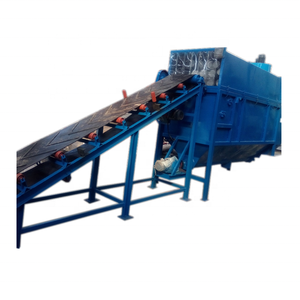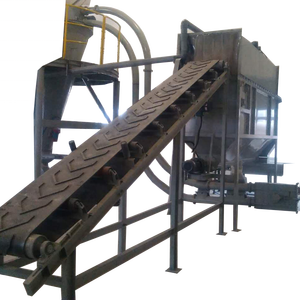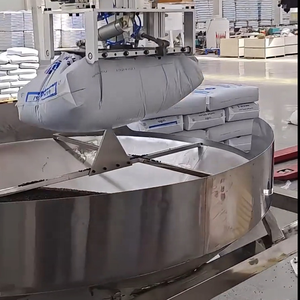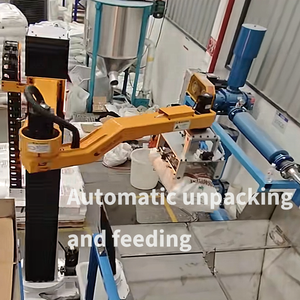
All categories
Featured selections
Trade Assurance
Buyer Central
Help Center
Get the app
Become a supplier

(1303 products available)







































Stationary Dumping Box Floor Type
The floor-type unloader is a stationary box that requires emptying by tilting the sack manually. It is also called a stationary dumping box floor type. Though slow, it suits small quantities or when tools like shovels are required for total bulk material removal from sacks. The low construction outlook of this design makes it easy for users to empty the load by transferring the content with little effort. Hence, it is commonly used in the processing plants of minerals, chemicals, and food products.
Rolling Dump Box Type
The rolling dump box is a moving container that holds the shovel and allows the user to roll the box to dump the contents. This box is designed to minimize labor by enabling users to dump bulk sacks manually using their hands. Users will roll the box to the dumping position. This is beneficial even when many empty bulk bags are needed. These boxes are common in steel and fabric-covered explosives applications that need higher corrosion resistance.
Hoisting Dump Box Type
The hoisting dump box is a stationary emptier that requires hoisting the empty bag and leaving the materials freely. Though most efficient, this technique is less efficient when many residues are inside the box after discharge. This design involves lower labor costs as the system has been built to limit manual work. This type is often found in paint, explosives, and other chemicals that require an unloader with a higher safety requirement.
Stationary Dumping Box with Vibrator
The stationary dumping box with a vibrator is a stationary box fitted with a vibrating element that helps in the discharge of materials from the empty sack. Vibration helps loosen and discharge even the most difficult materials. The vibrator often comes in handy when the material tends to bridge or rat hole within the container. This type is effective for powder or granular products in the chemical, pharmaceutical, and food industries and is anticipated to discharge reliably.
Pharmaceutical Industry
Sack unloaders are extensively used to expel raw materials like active pharmaceutical ingredients, excipients, and bulk chemicals. They have been constructed with enclosures that prevent product contamination and have been fitted with dust control measures that ensure compliance with cleanroom standards. Controlling dust gives a controlled environment with minimal exposure to allergens and harmful chemicals.
Agriculture Industry
Agricultural industries utilize sack unloaders to empty fertilizers, grains, and other bulk agricultural products. They are designed with durability to tackle hard materials and adverse weather elements. Conveyors used to transport the materials around farms, processing facilities, and storage units from unloader boxes play a vital product movement role.
Construction Industry
Sack unloaders in the construction industry empty materials such as cement, sand, and other bulk aggregates. They are designed with strength in order to withstand heavyweights and challenges that such elements bring. Many of them are also equipped with dust suppression mechanisms to maintain safety on the ground at construction sites. They help convey materials around projects to minimize manual work and increase efficiency.
Food Processing Industry
Food processing industries use dust-free enclosed sack unloaders to eliminate sugar, flour, salt, and other bulk food ingredients. These unloaders are specifically designed to meet hygiene requirements and keep foodstuffs free of impurities and contaminants. Please note that the unloader is designed to withstand caustic cleaning procedures and is fitted with anti-contaminant mechanisms.
Chemical Industry
Sack unloaders are commonly used in the chemical industry to convey substances such as pigments, powders, and granular chemicals. These unloaders are specified with premium safety features to reduce risks associated with hazardous materials. Examples are dust collection units, explosion-proof components, and chemical-resistant materials. The unloaders are important in the automatic transfer of materials from bags into production lines.
Mining and Mineral Processing Industry
The mining and mineral processing industries utilize heavy-duty sack unloaders to empty ores, miner and bulk powders, and materials like aggregates. Most of them are built with strength and durability and have been designed to handle rough materials, sometimes with bigger grain sizes and harder than normal. They can even generate more bridge formation and require higher force to empty. The unloaders are connected to conveyor systems that transport the materials to processing plants or storage areas within the mine due to their high capacity.
Bag criteria
The bag used for unloaded items should be made of polythene, polypropylene, or other appropriate materials. The pallets should preferably be of 1 or 2-string styles from top to bottom. The bags should be welded or stitched at the seams for proper performance.
The unloader should be capable of handling bags of different dimensions
Suffix ≤ 1.2m (4ft) in height and 1.2m (4ft) in width and 2.0m (6ft) in length. Bag weight should be between 500kg (1100 lbs) and 2000kg (4400 lbs).
Construction Materials
Frame, hoist, hopper, and other structures in contact with the loading should be made with stainless steel AISI 304 or AISI 316, which are common for chemical and food processing due to high resistance against corrosion. Other parts include mild steel painted or mild galvanised steel for industrial or warehouse use.
Loading Hopper
The loading hopper should have variable volume with features like chicanes, slide gates, and flap gates that can adjust it. A suitable volume should be 500 litres to 3000 litres with a discharge outlet of 200mm to 600mm diameter or square.
Performance
Max bag piercer throughput: 10 bags/hr. Vacuum Group for powders only - 50/60Hz, IP54, 3 phased, ø 0.73 mm wire 32.0m (105ft) max tube length. IoT industrial available via RS232, Ethernet TCP/IP, modbus RTU.
Electrical specifications
Power: 230V, –6% +10%, approximately 3% max alternating currents. Frequency: 50/60 Hz. Insulation class: F. Protection class: IP 54.
Maintenance
Refer to user manual for specific maintenance guidance. Maintenance should be done on seal wear, vacuum part wear, and wear of consumables like splines and syncro parts.
Follow these steps to achieve an ideal installation of a sack unloader:
Material Selection
Choose unloader clients made of premium materials such as steel or stainless steel enhanced for structural strength and corrosion resistance. These materials often perform optimally over time in most severe conditions.
Design and Engineering
Select unloaders with superior design features, rigidity structures, anti-jamming mechanisms, dust control options, and vibration supports. These elements enhance performance and reduce wear.
Brand R reputation and user reviews
Consider brands with a stellar reputation and reviews from customers who have written about experiences using the product. They can paint the real picture of how effective and reliable it is.
Compliance Standards
Make sure the chosen unloader meets vital industry regulations and as per company safety and quality guidelines. This includes AQAP and other relevant standards compliance in the industry unloader operates.
Testing and Certification
Give preference to unloaders that have passed vigorous performance and safety tests and are endorsed by independent certification services, further helping measure their quality assurance.
Regular Inspection
Make it a point to frequently inspect the vibrant bulk bag unloader for damage, wear and tear, and general instability. Check the frame and mechanized parts for signs of cracks or dulling.
Lubrication
This equipment requires adequate lubrication at joints and moving contact surfaces as per manufacturer's instructions to decrease friction and keep parts from wearing out fast.
Dust Control Measures Maintenance
Maintain dust suppression devices such as bags and filters by changing them periodically and cleaning them to enable better air flow; dust accumulation can cause dangerous conditions and reduce unloader efficiency.
Check Safety Features
Frequent test and check for emergency brakes, guards, and any other safety features in place to ensure when one has to rely on them, they function properly.
Alignment and Leveling
Ensure ground-level situated unloader remains aligned with ancillary equipment, such as conveyors; misalignment can cause hours and tend not to work at full capacity.
Repair and Replacement
Act on signs of wear as they come and prepare to repair or change parts such as bearings and joints that can have a negative impact on the performance of the unloader if left unchanged for a long while.
A1: A bulk bag unloader empties the content of an industrial sack, creating an efficient automated process for handling bulk materials. It works by supporting the bag, tensioning the bag's neck, and controlling the discharge process.
A2: Regularly applied lubrication, consistent inspection, and dust clearing are ideal maintenance strategies for pit unloaders to maintain their working condition for a long while.
A3: Automation enhances productivity through increased throughput, reduced labor costs, and minimized employee exposure to hazardous materials. Also, accuracy in material handling is higher.
A4: Key factors include bag size and material, the type of bulk material to be handled, required discharge rate and capacity, available space, and energy needs when selecting a suitable bulk bag unloader.
A5: Employers should ensure that proper guarding systems, regular maintenance, and operator safety training are provided to ensure safe work practices when handling sack unloaders.